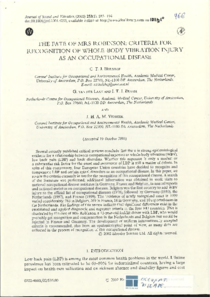The fate of Mrs Robinson: criteria for recognition of whole-body vibration injury as an occupational disease

Hulshof, Carel T.J. ; van der Laan, Gerrit ; Braam, Ingrid T. ; Verbeek, Jos H.
Journal of Sound and Vibration
2002
253
1
185-194
compensation of occupational diseases ; criteria document ; exposure ; occupation disease relation ; schedule of occupational diseases ; whole body vibration
Occupational diseases
English
Bibliogr.
"Several recently published critical reviews conclude that there is strong epidemiological evidence for a relationship between occupational exposure to whole-body vibration (WBV), low back pain (LBP) and back disorders. Whether this exposure is only a modest or a substantial risk factor for the onset and recurrence of LBP is still a matter of debate. In spite of this controversy, four European Union countries have decided to recognize and compensate LBP and certain spinal disorders as an occupational disease. In this paper, we review the criteria currently in use for the recognition of this occupational disease. A search of the literature was performed; additional information was obtained in work visits to national occupational disease institutes in Germany, France and Belgium, in annual reports and national statistics on occupational diseases. Belgium was the first country to add WBV injury to the official list of occupational diseases (1978), followed by Germany (1993), the Netherlands (1997), and France (1999). The incidence of newly recognized cases in 1999 varied considerably: 763 in Belgium, 269 in France, 16 in Germany, and 10 reported cases in the Netherlands. The findings of this review indicate that significant differences exist in the established and applied diagnostic and exposure criteria in the four EU countries. This is illustrated by the case of Mrs Robinson, a 41-year-old forklift driver with LBP, who would probably get recognition and compensation in the Netherlands and Belgium but would be rejected in France and Germany. The development of uniform internationally accepted criteria is recommended, also from an epidemiological point of view, as many data are collected in the process of recognition of this occupational disease. "
Digital
The ETUI is co-funded by the European Union. Views and opinions expressed are however those of the author(s) only and do not necessarily reflect those of the European Union or the ETUI.